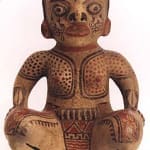Galo Polychrome Squatting Female Figure, 500 CE - 1000 CE
Terracotta
8.5
PF.3584
This seated female figure giving birth comes from the Guanacaste-Nicoya polychrome tradition, the Galo polychrome style. Its mirror-bright burnished surfaces are technically unsurpassed by any Pre-Columbian pottery, and yellows, reds,...
This seated female figure giving birth comes from the Guanacaste-Nicoya polychrome tradition, the Galo polychrome style. Its mirror-bright burnished surfaces are technically unsurpassed by any Pre-Columbian pottery, and yellows, reds, oranges, creams, maroons, and blacks of the polychrome decorations are impressively vivid. Among such sculptures are the full human figures with elaborate representations of tattoos or body paint. Such brilliant polychrome tradition represent an important social dimension; when the northern trade network that brought jade, slate-backed pyrite mirrors, foreign ceramics, and other luxury goods, the Nicoyans responded by producing their own special purpose pottery. Inspired by northern models, it also incorporated local and southern elements, forming a dazzling hybrid style that was traded around Central America and southern Meso-America in the centuries to come. Elaborately decorated with colors and patterns, this sculpted female is a dramatic depiction of femininity and fertility. A fine example of Galo polychrome figures, she provides a wealth of ethnographic detail because of the realistic style. Her flat headdress, earspools, and body painting or tattooing are all vividly shown. The body painting is symmetrical, further accentuating the refined beauty of the sculpture. The body painting also shows that she is wearing a tanga, a loincloth. With both of her hands firmly placed on her thighs, she is clearly conscious of her existence and feminine grace. Perhaps a noble woman or a priestess, she captures our eyes in an instant.



